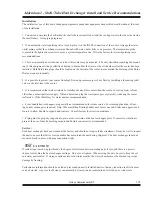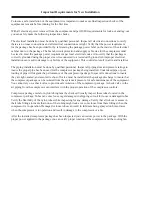
Addendum 2 - Shell /Tube Heat Exchanger Install and Service Recommendations
Quincy Compressor-QSI
®
131
Installation:
The satisfactory use of this heat exchanger equipment is dependant upon precautions which must be taken at the time
of the installation.
1. Connect and circulate the hot fluid in the shell side (over small tubes) and the cooling water in the tube side (inside
the small tubes). Note piping diagrams.
2. If an automatic water regulating valve is used, place it on the INLET connection of the cooler. Arrange the water
outlet piping so that the exchanger remains flooded with water, but at little or no pressure. The temperature probe
is placed in the hydraulic reservoir to sense a system temperature rise. Write the factory for water regulating valve
recommendations.
3. There are normally no restrictions as to how this cooler may be mounted. The only limitation regarding the mount
-
ing of this equipment is the possibility of having to drain either the water or the oil chambers after the cooler has been
installed. Both fluid drain plugs should be located on the bottom of the cooler to accomplish the draining of the fluids.
Drains are on most models.
4. It is possible to protect your cooler from high flow and pressure surges of hot fluid by installing a fast-acting relief
valve in the inlet line to the cooler.
5. It is recommended that water strainers be installed ahead of this cooler when the source of cooling water is from
other than a municipal water supply. Dirt and debris can plug the water passages very quickly, rendering the cooler
ineffective. Write the factory for water strainer recommendation.
6. Fixed bundle heat exchangers are generally not recommended for steam service. For steam applications, a float
-
ing bundle exchanger is required. Note: When installing floating bundle unit, secure one end firmly and opposite end
loosely to allow bundle to expand and contract. Consult factory for selection assistance.
7. Piping must be properly supported to prevent excess strain on the heat exchanger ports. If excessive vibration is
present, the use of shock absorbing mounts and flexible connectors is recommended.
Service:
Each heat exchanger has been cleaned at the factory and should not require further treatment. It may be well to inspect
the unit to be sure that dirt or foreign matter has not entered the unit during shipment. The heat exchanger should be
mounted firmly in place with pipe connections tight.
CAUTION!
If sealant tape is used on pipe threads, the degree of resistance between mating parts is less, and there is a greater
chance for cracking the heat exchanger castings. Do not over tighten. When storing the unit, be sure to keep the oil
and water ports sealed. If storage continues into cold winter months, the water chamber must be drained to prevent
damage by freezing.
Performance information should be noted and recorded on newly installed units so that any reduction in effectiveness
can be detected. Any loss in efficiency can normally be traced to an accumulation of oil sludge, or water scale.
Содержание QSI Series
Страница 2: ......
Страница 7: ...Section I General Quincy Compressor QSI 5 MODEL IDENTIFICATION...
Страница 62: ...Section IV Operating Procedures 60 Quincy Compressor QSI 1 Week Timer 2 Remaining Running Time...
Страница 79: ...Section IV Operating Procedures Quincy Compressor QSI 77...
Страница 140: ...Table of Contents Quincy Compressor QSI...










































